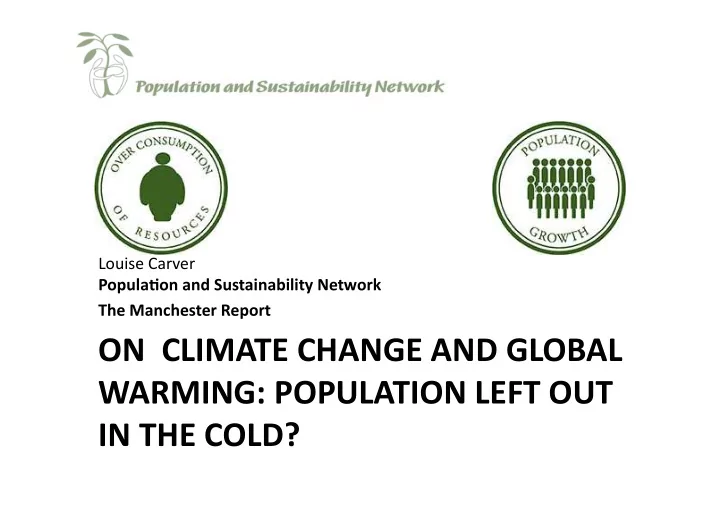

Louise Carver Popula;on and Sustainability Network The Manchester Report ON CLIMATE CHANGE AND GLOBAL WARMING: POPULATION LEFT OUT IN THE COLD?
Outline for this talk: 1. Current trends in global popula5on 2. Climate change and popula5on: Popula5on and GHG emissions Popula5on and vulnerability/ adapta5on 3. Recommenda5ons for ac5on?
Global popula5on growth paEerns World Popula;on Growth to 2050 Distribu;on of Growth to 2150 United Na5ons World Popula5on Prospects 2008 Revision United Na5ons World Popula5on Prospects 1998 Revision • Projec5ons in 2050 are built on assump5ons • Over 95% of popula5on growth from today will take place in urban centers in the global south.
Popula5on Ac5on Interna5onal
Global Distribu;on of Consump;on PaPerns : GHG Emissions Per Person 2004 Na;onal GHG Emissions 2005 Sds • Unconscionable to claim that the poor countries in the South, that are largely the engine of population growth are responsible for climate change today
The KAYA Iden;ty shows that popula;on is an important driver of climate change from energy use:
Popula5on features in the models by IPCC: Special Report on Emissions Scenarios (SRES) A1 A2 B1 B2 Popula5on Low High Low Medium growth GDP growth Very High Medium High Medium Technological Rapid Slow Medium Medium change Energy use Very High High Low Medium Land use Low/ Medium High Medium Medium /High Emissions in MEDIUM HIGH LOW MEDIUM 2100
Stones leX unturned in the models… • Other demographic Impacts of aging and urbanisa;on on carbon emissions in China variables will impact on emissions for example: – Aging – Urbaniza;on – Household size Popula5on Ac5on Interna5onal 2009
There is an opportunity… If there is a fixed long‐term policy goal for climate change, how much less costly would it be, how much less would you have to spend on changing the energy system, for example, to reach that goal, if there was a lower popula5on path rather than a medium one? Brian O’Neill, Earth Scien5st, Na5onal Center for Atmospheric Research, USA.
Popula;on should be included in discussions: • We can associate a lower popula5on with a lower emission pathway, but it won’t guarantee it on its own... • Addressing rapid popula5on increase has many other important benefits. • It needs to be beEer framed in climate change discussion, since currently it is simply omiEed.
Popula;on and Adapta;on to Climate Change
Climate Change Impacts on People and Popula;ons: Half of world’s popula;on to Temperature Rise suffer food shortages by 2050 Unpredictable precipita;on 1‐2 billion to suffer water shortages by 2050 Sea level rise Third of global popula;on Flood lives within 60 miles of a Shoreline Increase in storm severity Increase in diseases: Glacial mel;ng Diarrhea, malaria and malnutri;on
Vulnerability is defined as: “The degree to which a system is suscep5ble to, or unable to cope with, adverse effects of climate change, including climate variability and extremes. Vulnerability is a func5on of the character, magnitude, and rate of climate varia5on to which a system is exposed, its sensi5vity, and its adap5ve capacity.” (IPCC, 2001, p. 995)
Poor countries will be hit earliest and hardest : • Most vulnerable to impacts • Have less capacity to adapt • Rapid popula;on growth and high fer;lity underscores both
Popula;on growth undermines development efforts and can sustain poverty : • Maternal health (one in five deaths for women is due to pregnancy related causes) • Educa5on (primary school enrolment is lower amongst women with large families) • Hinders economic growth • Environmental degrada5on
Guiding principle: Individuals cannot exercise adequate stewardship over natural resources unless their basic needs for health, nutri;on and economic well‐being are addressed. (PAI 2009)
Climate Change adds an extra dimension to pop‐ environment model Rapid popula5on growth can make adapta5on to the changes and impacts much harder
Na;onal Adapta;on Programmes of Ac;on (NAPA) • SubmiEed by Least Developed Countries to the UNFCCC to outline urgent vulnerabili5es: important resource from perspec5ve of developing countries themselves • 41 countries have submiEed a NAPA so far • Over 90% men;on rapid popula;on growth as something that either exacerbates vulnerability or impedes ability to adapt • More than half of the countries will at least double in popula5on by 2050
Some areas of vulnerability shown in NAPA reports: Flooding Drought Soil Degrada;on/ Over farming Water Shortages Biodiversity Loss Deser;fica;on Deforesta;on Coastal Erosion and Sea Level Rise
Popula;on growth underwrites these vulnerabili;es in three major ways: 1) Popula5on growth and climate change act cumula5vely to deplete the source of key natural resources, for example through soil erosion and deforesta5on, ‐ ( availability) 2) Popula5on growth is projected to cause a significant escala5on in demand for resources that climate change diminish, including fresh water and food, ( demand) 3) Rapid popula5on growth heightens human vulnerability to natural disasters caused by climate change, including by forcing more people to migrate and seEle in areas at risk of floods, storms and drought.
Popula;on growth and specific vulnerabili;es: • On water resources: Na$onal studies have shown that soil moisture would decline under future climate change. When coupled with high consump$on, increased popula$on growth, high varia$on in rainfall and high rate of evapora$on, a looming water crisis appears likely. Sudan NAPA. p.19 2007
Popula;on growth on specific vulnerabili;es con;nued… • On shortage of land per capita: Vulnerable regions receive more and more migra$ng popula$ons from regions with high density of popula$on and where natural resources have reached a cri$cal level of degrada$on.” Rwanda NAPA, P. 37. 2006
On Health “The high popula5on and growth rate of Uganda is not matched with growth in health services and wealth… the high popula5on puts addi5onal stress on the natural resources and weak health infrastructure” Uganda NAPA, p. 11 Picture: Marie Stopes Interna5onal
Recommenda;ons for Ac;on: • Renew and honor commitments made to reproduc;ve health, including importantly family planning • Invest in female educa;on • Streamline climate change adapta;on with all development efforts‐ bePer integra;on across sectors • Improve data collec;on and research materials
Recommend
More recommend